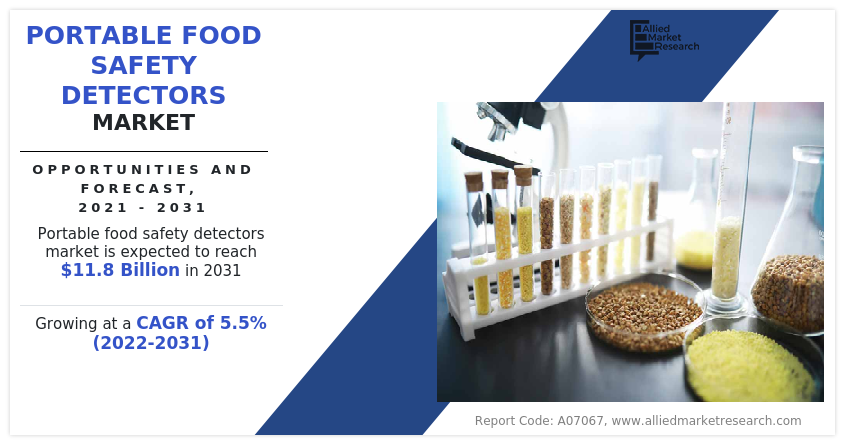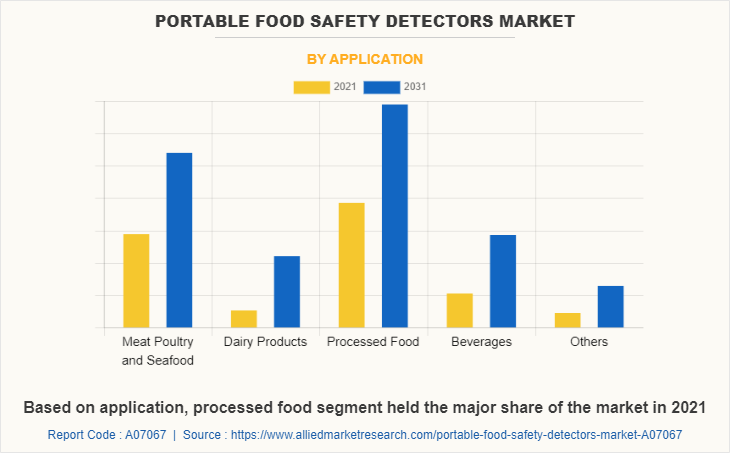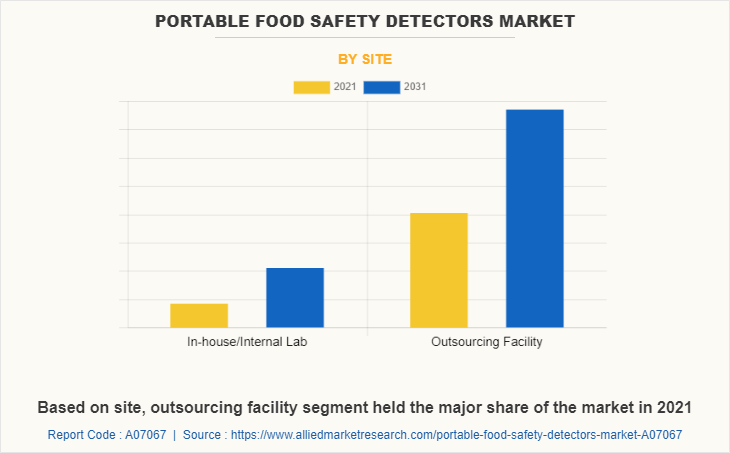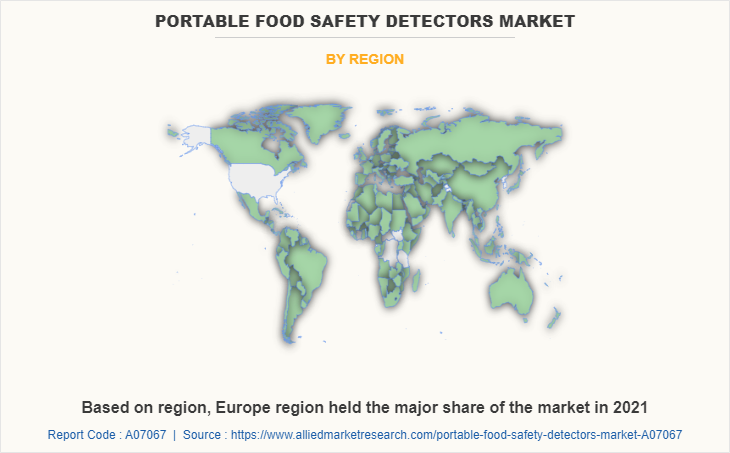The global portable food safety detectors market size was valued at $6.9 billion in 2021 and is projected to reach $11.8 billion by 2031, growing at a CAGR of 5.5% from 2022 to 2031.

The portable food safety detectors market is segmented into Application and Site.
A portable food safety detector is used to enhance consumer safety and product transparency by providing real-time information on food & beverage within minutes. This device is an easy-to-use electronic device that allows consumers to detect various contaminants and food allergens in food & beverages. Portable food safety detectors can detect allergens such as peanut proteins, gluten, and contaminants such as antibiotics and pesticides. Several types of portable food safety detectors are offered by manufacturers for commercial and domestic use.
The increase in focus on food safety regulations globally drives the demand for portable food safety detectors. Food safety regulations require the food industry to test food products for harmful substances, pathogens, or contaminants, and portable food safety detectors provide a convenient and efficient solution for this which is expected to fuel the growth of the portable food safety detectors industry
Food safety remains a major concern among consumers. The presence of biological toxins and unsafe levels of chemicals in food represents a serious threat to the safety of the food and public health. According to the World Health Organization, foodborne illnesses affect the economy of underdeveloped countries. Food safety issues in developing countries are widely recognized; estimates indicate that out of 1500 annual diarrheal episodes occurring globally, 75% of the cases are attributed to biological contamination of food, which results in around three million deaths annually. Rapid and accurate analysis of food products draws considerable attention in the modern pace of the world owing to the close relationship between human health and food safety. Traditional detection technologies for food evaluation are restricted by lengthy time, excessive cost, bulky instruments, and skilled personnel which is expected to propel the growth of the portable food safety detectors market. The increase in the adoption of portable food safety detectors for commercial as well as domestic use is expected to propel the growth of the portable food safety detectors industry in the upcoming years.
Governments around the world have implemented increasingly stringent food safety regulations, requiring food producers and handlers to use more advanced testing methods to ensure the safety of their products. This drives the demand for portable food safety detectors to comply with these regulations. Falsification and economically motivated adulteration are some of the biggest fraudulent acts in the food industry. The intake of contaminated food, comprising of toxic chemicals and radioactive materials, results in food-borne sicknesses, which might turn out to be fatal. Some of the major food fraud activities include the recycling of animal by-products, the sale of goods past their “use by” date, fake statements about ingredients, and unsafe food handling processes. However, many leading food safety organizations, such as Food Safety and Inspection Service detect and mitigate such deliberate actions, with growth in focus toward food safety. Food safety agencies widely use portable food safety detectors for rapid testing of the contaminants in the food products and raw materials. The implementation of such rigorous regulations to prevent food fraud is expected to drive the growth of the portable food safety detectors market.
The quality of food is being intentionally degraded with the motive of making higher profits. Food adulteration includes the intentional addition or substitution of substances and incidental contamination during the growth, harvesting, handling, transportation, and distribution of food products. Adulterated food is life-threatening, as it is toxic and deprives key nutrients that affect health adversely. Milk-based products, seafood, and honey are the most adulterated food products. Food safety authorities ensure that domestic and imported food products are safe, healthy, and accurately labeled to minimize these false practices. The introduction of Prohibited Acts under the Federal Food, Drug, and Cosmetic Act (FFDCA) has resulted in reduced fraudulent and economically motivated adulteration incidents, which fuels the growth of the portable food Safety detectors market.
Food producers have witnessed high competition over the years due to developments in the food industry. The intentional adulteration of food products to generate high profits poses health risks and has affected the economy, businesses, and consumers. For instance, paying a high price for horsemeat over beef is like paying high for a cheaper substitute, thereby disturbing the overall economy. Therefore, food safety authorities and import authorities aggressively make efforts to combat economically motivated adulteration incidents. Some of the principal federal agencies in the U.S., such as the Food and Drug Administration (FDA) and the U.S. Department of Agriculture (USDA) protect the food supply from intentional and unintentional food safety risks with the enforcement of FDA and USDA laws. For instance, USDA’s Food Safety and Inspection Service (FSIS) controls meat, poultry, & egg products and possess authority over food & food ingredients to tackle fraudulent activities. In addition, other agencies, for instance, the U.S. Department of Justice (DOJ) and USDA’s National Organic Program (NOP) have taken constant legal actions against companies involved in the false labeling of organic food and fake claims on the validity of organic food. These factors altogether drive the growth of the portable food safety detectors market.
Technological advances in the field of portable food safety detectors, such as the development of more sensitive and accurate sensors, are anticipated to drive market growth and provide new opportunities for companies to differentiate their products and capture market share. Advances in sensor technology have led to the development of more sensitive and accurate sensors that can detect food-borne pathogens and contaminants. This has improved the accuracy of portable food safety detectors, making them more reliable and effective. The miniaturization of portable food safety detectors has made them more compact, portable, and convenient to use. This made it easier for food producers and handlers to use these devices in the field, which has helped to increase the adoption of these devices. The integration of big data analytics with portable food safety detectors has enabled the analysis of substantial amounts of data, providing insights into food safety trends and allowing for more effective monitoring and control of food safety. The integration of connectivity technologies, such as Bluetooth and Wi-Fi, has made it easier to transfer data from portable food safety detectors to other devices, such as smartphones and laptops, for analysis and reporting. Overall, these technological advances have improved the performance and efficiency of portable food safety detectors, and they are anticipated to continue to play a significant role in the growth of the market in the upcoming years.
Existing technologies for food testing involve various difficulties in providing valid test results. The food sample needs to go through various tests such as food chemical analysis, food allergen testing, food contaminant testing, food contact tests, nutritional analysis & testing, genetically modified organisms testing, microbiological tests, melamine contamination testing, spiral plating for the bacterial count, and others to ensure the food product is safe. the increase in adoption of portable and less time-consuming food detectors is expected to propel the growth of the market during the portable food safety detectors market forecast
Moreover, there are technical limitations associated with portable food safety detectors, including issues with accuracy and sensitivity. While these limitations are being addressed through technological advancements, they still pose a challenge to the market and limit the widespread adoption of these devices. In addition, there is a lack of standardization in the portable food safety detector market, which creates confusion for customers and limits the growth of the market. This is since different devices use different testing methods and may produce different results, making it difficult for customers to choose the right device for their needs. Therefore, these factors are expected to hinder the portable food safety detectors market growth in the upcoming years.
The portable food safety detectors market is segmented into application, site, and region. On the basis of application, the market is divided into meat poultry & seafood, dairy products, processed food, beverages, and others. By site, the market is divided into in-house/internal lab and outsourcing facilities. Region-wise, the market is analyzed across North America (the U.S., Canada, and Mexico), Europe (Germany, France, Italy, Spain, UK, Russia, and rest of Europe), Asia-Pacific (China, Japan, India, South Korea, Australia, Thailand, Malaysia, Indonesia, and rest of Asia-Pacific), and LAMEA (Brazil, South Africa, Saudi Arabia, UAE, and rest of LAMEA).

By application, the processed food segment held the major portable food safety detectors market share, in terms of revenue, in 2021 as portable food safety detectors are widely used in the food and beverages industry to check the quality of processed food and beverages. A portable food safety detector is a compact and handheld device used to test the safety and quality of food products in the food industry. This technology can provide real-time results, allowing food industry workers to quickly detect harmful substances, pathogens, or contaminants in food products.

By site, the outsourcing facility segment held the major portable food safety detectors market share. Portable food safety detectors in an outsourcing facility help to improve quality control and food safety practices. In an outsourcing facility, various food products are processed, packaged, and prepared for distribution. The use of a portable food safety detector provides real-time results and enables facility workers to quickly detect any harmful substances, pathogens, or contaminants that are present in food products.

Region-wise, Europe was the largest market in 2021 and had the highest market share of 36.8%. The demand for portable food safety detectors in Europe is being driven by strict food safety regulations. Portable food safety detectors do quick and accurate detection of harmful substances, pathogens, or contaminants which is expected to propel the growth of the portable food safety detectors market in the region. This helps to ensure that only safe and high-quality food products reach consumers.
The players in the portable food safety detectors market have adopted acquisition, business expansion, partnership, collaboration, and product launch as their key development strategies to increase profitability and improve their position in the market.
Some of the key players profiled in the portable food safety detectors market analysis include Allergy Amulet, ALS Ltd., BioSensor Laboratories, Bureau Veritas S.A., Calibration Technologies, LLC., CDx, Inc., DETECTRONIC A/S, Eurofins Scientific, Foodsense, Intertek Group plc, Mérieux NutriSciences, Nima, Optosky, SGS S.A., and Xiamen Haihongxing Instrument Co., Ltd.
Key Benefits For Stakeholders
- This report provides a quantitative analysis of the market segments, current trends, estimations, and dynamics of the portable food safety detectors market size from 2021 to 2031 to identify the prevailing portable food safety detectors market opportunities.
- The market research is offered along with information related to key drivers, restraints, and opportunities.
- Porter's five forces analysis highlights the potency of buyers and suppliers to enable stakeholders to make profit-oriented business decisions and strengthen their supplier-buyer network.
- In-depth analysis of the portable food safety detectors market segmentation assists to determine the prevailing market opportunities.
- Major countries in each region are mapped according to their revenue contribution to the global market.
- Market player positioning facilitates benchmarking and provides a clear understanding of the present position of the market players.
- The report includes an analysis of the regional as well as global portable food safety detectors market trends, key players, market segments, application areas, and market growth strategies.
Portable Food Safety Detectors Market Report Highlights
| Aspects | Details |
| Market Size By 2031 | USD 11.8 billion |
| Growth Rate | CAGR of 5.5% |
| Forecast period | 2021 - 2031 |
| Report Pages | 306 |
| By Application |
|
| By Site |
|
| By Region |
|
| Key Market Players | Thermo Fisher Scientific Inc. , Institut Merieux, Calibration Technologies, LLC, Zimmer and Peacock Ltd., PerkinElmer Inc., Agilent Technologies, Inc., NIMA Partners, LLC., Metrohm AG, Bio-Rad Laboratories, Inc. , Smiths Group PLC |
Analyst Review
According to the insights of CXOs of leading companies, the portable food safety detectors market holds a substantial scope for growth; however, its contribution to the world market will increase significantly within the next six years. Innovation is the key to the success of the portable food safety detectors market.
The increase in awareness about portable food safety detectors is expected to create more opportunities for manufacturers in the upcoming year. Economically motivated adulteration (EMA) has rapidly increased in the market, which is a major health threat for consumers. Meat and processed food product segments are anticipated to witness the highest growth rate during the forecast period.
U.S. is expected to witness significant growth on account of an increase in processed food production and a surge in food safety concerns among consumers. Furthermore, supportive government policies regarding food testing in the country coupled with foreign investments in the food & beverage industry are anticipated to boost the market for food safety testing during the forecast period.
The global portable food safety detectors market size was valued at $6.9 billion in 2021 and is projected to reach $11.8 billion by 2031
The global Portable Food Safety Detectors market is projected to grow at a compound annual growth rate of 5.5% from 2022 to 2031 $11.8 billion by 2031
Calibration Technologies, LLC, Thermo Fisher Scientific Inc. , Smiths Group PLC, Metrohm AG, Zimmer and Peacock Ltd., PerkinElmer Inc., NIMA Partners, LLC., Bio-Rad Laboratories, Inc. , Institut Merieux, Agilent Technologies, Inc.
Region-wise, Europe was the largest market in 2021
Technological advances in the field of portable food safety detectors, such as the development of more sensitive and accurate sensors that can detect food-borne contaminants and pathogens, Stringent food safety regulations that require food handlers and producers to use more advanced testing methods, Implementation of rigorous rules to prevent food fraud
Loading Table Of Content...
Loading Research Methodology...



